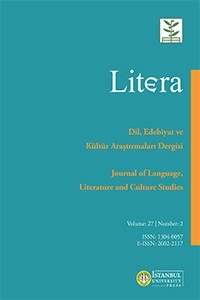A Micrology of Pattern Recognition in Philip K. Dick’s A Scanner Darkly
A Micrology of Pattern Recognition in Philip K. Dick’s A Scanner Darkly
This article is a conjointly formal and thematic inquiry dedicated to unpacking the internal coherence of Philip K. Dick’s A Scanner Darkly (1976). Organized around the unifying problem of pattern recognition, the article clarifies the deep congruence that exists between the seemingly unrelated imaginary technologies of the novel, used on both sides of the central demarcation that divides the identity of its protagonist: law enforcement and the trade in controlled substances. While it benefits from concepts designed to investigate science fiction as a genre, it also brings in discourses developed to make sense of media technologies in the real world. Guarding against the danger of eclipsing the text under information about the media historical context, this article allies media theory with narrative analysis and relies on “micrology” as a strategy of selective close reading following the logic of detection, recognition, and the failures thereof in the novel. This manner of inquiry allows me to specify the nature of pattern recognition as a lost capacity in the narrative arc, tracking the problems of information theory and the decline of cognitive capacities, as well as demonstrating their immanence to a single complex of ideas. In this sense, what belongs to intellectual history in the following discussion, is subject to the requirement that it makes the technological and psychological aspects of the narrative more intelligible and respond to the unique challenges of its combination of estranging world-building and all too familiar countercultural tropes.
Keywords:
Scanning, camouflage, Gestalt, neurology abstraction,
___
- Alexander, Z. Ç. (2020). “Scanning: A technical history of form”. Design technics: Archaeologies of architectural practice. University of Minnesota Press. google scholar
- Arnheim R. (1974). Art and visual perception. University of California Press. google scholar
- Bateson, G. (2008). Steps to an ecology of mind. University of Chicago Press. google scholar
- Behrens, R. (2000). Revisiting Gottschaldt: Embedded figures. Gestalt Theory, Vol. 22 No. 2 google scholar
- Bell, V. (2006). Through a scanner darkly: Neuropsychology and psychosis in Philip K. Dick’s novel “A Scanner Darkly”. The Psychologist 19(8). google scholar
- Boon, M. (2015). Between scanner and object: Drugs and ontology in Philip K. Dick’s A Scanner darkly. The world according to Philip K. Dick. Palgrave. google scholar
- Dews, P. (2013). The idea of evil. Wiley-Blackwell. google scholar
- Dick, P. K. (1991). A Scanner darkly. Vintage. google scholar
- Dick, P. K. (1995). The shifting realities of Philip K. Dick: Selected literary and philosophical writings. Vintage Books. [Kindle DX version]. Retrieved from Amazon.com. google scholar
- Dick, P. K. (2006). Vintage PKD. Vintage Books. google scholar
- Dick, P. K. (2012). The exegesis of Philip K. Dick. Gollancz. [Kindle DX version]. Retrieved from Amazon.com. google scholar
- Durham, S. (1988). P. K. Dick: From the death of the subject to a theology of late capitalism. Science Fiction Studies, Vol. 15, No. 2, pp. 173-186. google scholar
- Caillois, R. (1960). Meduse et cie. Gallimard. google scholar
- Forbes P. (2009). Dazzled and deceived: Mimicry and camouflage. Yale University Press. google scholar
- Gombrich E. H. J. (1984). Art and illusion: A study in the psychology of pictorial representation. Phaidon. google scholar
- Harrington A. (1996). Reenchanted science: Holism in German culture from Wilhelm II to Hitler. Princeton University Press. google scholar
- Lee, E. (2017). Collapsed horizon: Philip K Dick’s A Scanner darkly, 40 years on. The Quietus. google scholar Lund, N. (2020). Attention and pattern recognition. Routledge. google scholar
- McLuhan, M. (1964). Understanding media: The extensions of man. New York:McGraw-Hill, google scholar
- Modern, J. L. (2021). Neuromatic or a particular history of religion and the brain. University of Chicago Press. google scholar
- Palmer C. (2003). Philip K. Dick: Exhilaration and terror of the postmodern. Liverpool University Press. google scholar
- Rossi, U. (2014). Philip K. Dick’s unconventional dystopias: From Radio free Albemuth to A Scanner darkly. Extrapolation, vol. 55, no. 2. google scholar
- Salisbury, L. (2016). Aphasic modernism: Languages for illness from a confusion of tongues. The Edinburgh companion to the critical medical humanities. Edinburgh University Press. google scholar
- Shell H. R. (2007). Hide and seek: Camouflage, photography, and the media of reconnaissance. Harvard University. Available from ProQuest Dissertations and Theses. google scholar
- Simondon, G. (2020). Individuation in light of notions of form and information. University of Minnesota Press. google scholar
- Sutin L. (2005). Divine invasions: A life of Philip K. Dick. Carroll & Graf. google scholar
- Suvin, D. (2002). Goodbye and hello: Differentiating within the later P.K. Dick. Extrapolation, Vol. 43 (4), p 368397. google scholar
- Wolk, A. (1995). The Swiss connection: Psychological systems in the novels of Philip K. Dick. Philip K. Dick: Contemporary critical interventions. Greenwood Press. google scholar
- Başlangıç: 1954
- Yayıncı: İstanbul Üniversitesi
Sayıdaki Diğer Makaleler
Medusa and Matisse: Myth and Art in A.S. Byatt’s “Medusa’s Ankles”
Collecting and Destroying Postcards: Discursive Travel in Lynne Tillman’s Motion Sickness
Mythopoeic Image of the City in T. S. Eliot’s The Waste Land
The Spectre and the Pin: Trompe-l’oeil and Hermeneutic Mourning in Hamnet
A Micrology of Pattern Recognition in Philip K. Dick’s A Scanner Darkly
A Study of Henrik Ibsen’s The Lady from the Sea from the Perspective of Ecofeminism
Deconstructive Critique of the Story «Cirios Rojos» by Segundo Serrano Poncela
E. M. Forster’ın “Makine Duruyor” Öyküsünde Teknososyal Bireyler ve ‘Prometheusçu Utanç’
Max Aub, a Body in Transit in a Lost Time: Reflections and Thoughts on Exile in His Works
